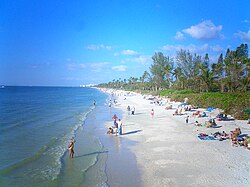A tropical climate is a climate typically found within the tropics, while a few locations outside the Tropics are considered to have a tropical climate. In the Köppen climate classification it is a non-arid climate in which all twelve months have mean temperatures of at least 18 °C (64 °F). Unlike the subtropics, where there are significant variations in day length and temperature to various degrees, with season, tropical temperature remains relatively constant throughout the year and seasonal variations are dominated by precipitation.

Locations of tropical climates, with subtypes.
Af—Tropical rainforest climate.
Template:Lgee
Aw—Tropical savanna climate.

Intertropical Convergence Zone vertical velocity at 500 hPa, July average in units of pascals per second. Ascent (negative values) is concentrated close to the solar equator; descent (positive values) is more diffuse.
Subtypes
Within the tropical climate zone there are distinct varieties based on precipitation:
- Tropical rainforest climate (Af): All twelve months have average precipitation of at least 60 mm (2.4 in). These climates usually occur within 5–10° latitude of the equator. In some eastern-coast areas, they may extend to as much as 25° away from the equator. This climate is dominated by the Doldrums Low Pressure System all year round, and therefore has no natural seasons
- Examples:
- Apia, Samoa
- Kisangani, Congo
- Mbandaka, DR Congo
- Bogor, Indonesia
- Davao, Philippines
- Klang, Malaysia
- Kuching, Malaysia
- Paramaribo, Suriname
- Quibdó, Colombia
- Ratnapura, Sri Lanka
- Singapore
- Examples:
- Tropical monsoon climate (Am): This type of climate, most common in South and Central America, results from the monsoon winds which change direction according to the seasons. This climate has a driest month (which nearly always occurs at or soon after the "winter" solstice for that side of the equator) with rainfall less than 60 mm, but more than (100 − [total annual precipitation {mm}/25]).
- Examples:
- Abidjan, Ivory Coast
- Cairns, Queensland, Australia
- Chittagong, Bangladesh
- Guanare, Portuguesa, Venezuela
- Huế, Thừa Thiên–Huế, Vietnam
- Jakarta, Indonesia
- Macapá, Amapa, Brazil
- Miami, United States
- Port Harcourt, Rivers State, Nigeria
- Puerto Ayacucho, Amazonas, Venezuela
- Sinop, Mato Grosso, Brazil
- Yangon, Myanmar
- Examples:
- Tropical wet and dry or savanna climate (Aw): These climates generally have a pronounced dry season, with the driest month having precipitation less than 60 mm and also less than (100 − [total annual precipitation {mm}/25]).

Beach in Naples, Florida lined with coconut trees is an example of a tropical climate. Although it lies in the subtropics over a hundred miles north of the tropic of cancer, the warm waters of the Gulf of Mexico give it a monthly mean temperature never under 18 °C (64 °F), classifying its climate as tropical.
- Examples:
- Innisfail, Australia
- Barquisimeto, Venezuela
- Cartagena, Colombia
- Ciudad Guayana, Venezuela
- Dar es Salaam, Tanzania
- Darwin, Northern Territory, Australia
- Dili, East Timor
- Fortaleza, Ceará, Brazil
- Ho Chi Minh City, Vietnam
- Honolulu, Hawaii, United States
- Jijoca de Jericoacora, Ceará, Brazil
- Kaohsiung, Taiwan
- Kupang, Indonesia
- Lagos, Lagos State, Nigeria
- Medellín, Colombia
- Mumbai, Maharashtra, India
- West Palm Beach, United States
- Fort Lauderdale, United States
- Naples, Florida, United States
- Fort Myers, Florida, United States
- Port-au-Prince, Haiti
- Rio de Janeiro, Rio de Janeiro, Brazil
- Valencia, Venezuela
- Veracruz, Veracruz, Mexico
Intertropical Convergence Zone
Because of the effect of sun angle on climate most areas within the tropics are hot year-round, with diurnal variations in temperature exceeding seasonal variations. Seasonal variations in tropical climate are dominated by changes in precipitation, which are in turn largely influenced by the tropical rain belt or Intertropical Convergence Zone (ITCZ), a portion of the Hadley cell. The ITCZ is shown, for July average, in the graphic. Areas of ascending air have heavy rainfall; areas of descending air are dry. The ITCZ somewhat follows the solar equator throughout the year, but with geographical variations, and in some areas (India) is heavily influenced by local large-scale monsoons.
References
- ^ a b c McKnight, Tom L; Hess, Darrel (2000). "Climate Zones and Types: The Köppen System". Physical Geography: A Landscape Appreciation. Upper Saddle River, NJ: Prentice Hall. pp. 205–211. ISBN 0-13-020263-0.
- ^ Linacre, Edward; Bart Geerts (1997). Climates and Weather Explained. London: Routledge. p. 379. ISBN 0-415-12519-7.
- ^ "CHAPTER 7: Introduction to the Atmosphere". physicalgeography.net. Retrieved 2008-07-15.
Wikipedia





No comments:
Post a Comment